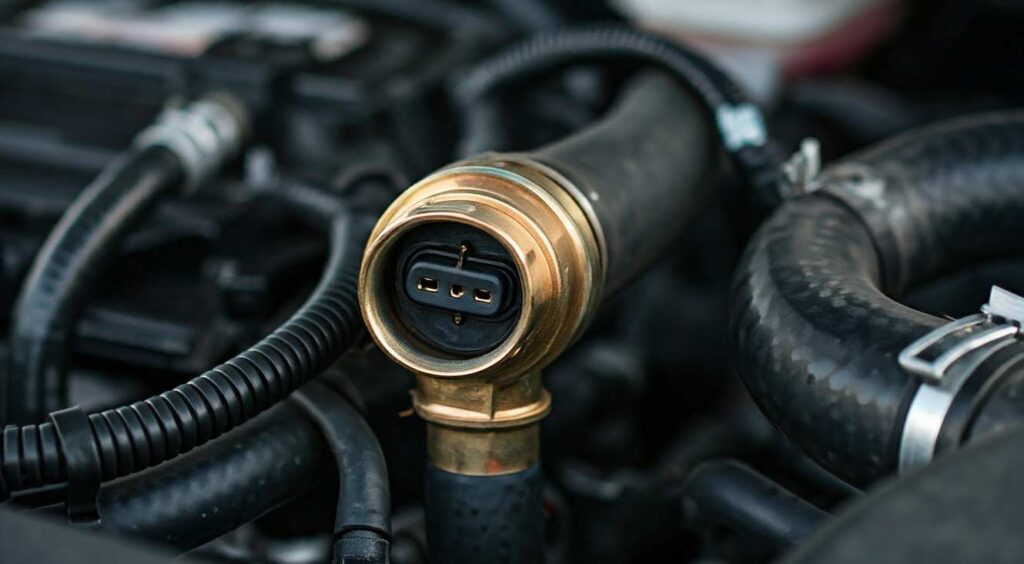A coolant temperature sensor is crucial in ensuring your car runs smoothly. It helps the engine control module (ECM) monitor the engine’s temperature and adjust fuel consumption and ignition timing accordingly. Now, if this sensor fails, things might get tricky. But can you drive with a faulty coolant temperature sensor? Let’s break it down.
What is a Coolant Temperature Sensor?
Your coolant temperature sensor (CTS) does a pretty important job. It measures the temperature of the engine’s coolant and tells the ECM how hot or cold the engine is. Based on this information, the ECM adjusts the fuel-air mixture, ensuring the engine operates efficiently.
In simpler words, without a working sensor, your engine’s computer has no idea how hot the engine is running, which could lead to several problems. Sometimes small, sometimes not.
Can You Drive With a Faulty Coolant Temperature Sensor?
Yes, technically you can drive your car if the coolant temperature sensor is faulty. However, that doesn’t mean you should. There are a few reasons why:
- Overheating Risk: A faulty sensor may not report the right temperature readings. Your engine control unit (ECU) might not know when the engine’s getting too hot, which could lead to overheating. The cooling fans, which rely on the sensor to kick in, may not activate in time. Engine overheating causes significant wear and tear, and it can cost you around $2,500 to $4,000 for engine repairs if not handled properly.
- Reduced Fuel Efficiency: If your sensor isn’t working, your engine’s air-fuel mixture might be off. This can lead to your vehicle either using too much or too little fuel. A car running rich (too much fuel) will burn more fuel than needed, lowering your mileage significantly. Poor fuel management can reduce fuel efficiency by up to 30%.
- Check Engine Light: You will most likely see your check engine light turn on. Ignoring this light might seem tempting, but doing so can mask other serious issues your vehicle may face.
Symptoms of a Bad Coolant Temperature Sensor
When the CTS goes bad, your car will start behaving oddly. Here are the common symptoms:
- Overheating Engine: As mentioned, if the sensor can’t send accurate readings to the ECM, your cooling fans might not kick in, leading to overheating.
- Poor Fuel Economy: A bad sensor often causes the car to run on a rich mixture, leading to increased fuel consumption.
- Black Smoke from Exhaust: This is a result of too much fuel burning in the engine. You might also notice rough idling or difficulty starting the engine.
- Starting Issues: Since the engine’s air-fuel ratio depends on the sensor, a faulty reading could mean trouble starting the engine, especially in cold conditions.
Dangers of Driving with a Faulty Coolant Temperature Sensor
- Possible Engine Damage: If the temperature isn’t monitored correctly, the engine may overheat, leading to blown gaskets, warped engine parts, or even a complete engine failure.
- Poor Performance: A bad coolant sensor affects your car’s overall performance. The wrong air-fuel ratio can cause rough idling, stalling, or even jerky acceleration.
- Emission Problems: Inaccurate temperature readings can also affect your car’s emissions control systems. You could end up failing emissions tests due to increased exhaust emissions, and in some states, that means you won’t be able to renew your registration until it’s fixed.
- High Repair Costs: What might start as a $100 sensor replacement could escalate into a much more expensive issue if you wait too long. Neglecting the problem can lead to significant engine damage.
Can Driving with a Faulty Coolant Temperature Sensor Harm Other Parts?
Yes, and it’s not just the engine you should worry about. A faulty sensor can affect your transmission as well. Many modern vehicles rely on the sensor’s data to control transmission shifts. Incorrect data can lead to poor shifting, which in turn could cause premature wear and tear on your transmission.
Get It Fixed Before It’s Too Late
In short, you can technically drive with a bad coolant temperature sensor, but it’s not advisable. It’s a small, relatively inexpensive part, but it has a significant impact on your vehicle’s performance and long-term health. Ignoring it could lead to more expensive repairs down the road. Always keep your car in top shape to avoid these unnecessary expenses and risks.

